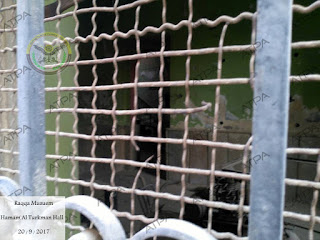The pieces, some 96 crates in total, weighing in at a whopping 5,000 kilos, had been trafficked illegally. The repatriated cargo includes two of the incredibly mysterious pre-Columbian spheres sculpted from gabbro, the coarse-grained equivalent of basalt, believed to have been created by the Diquís civilization, as well as pottery, vases, human figurines, zoomorphic ocarinas (musical instruments), and metates (grain-grinding stones).
The ancient cargo arrived to Port Moin in Limón, Costa Rica by boat on Tuesday, January 2, 2018 and concretized Guatemala's promise to return plundered goods, once part of a controversial private collector's extensive collection.
Found deep in the jungles of Costa Rica, the Las Bolas petrospheres (literally "the balls") of the Diquís civilization date back to the Aguas Buenas Period (300–800 CE) and Chiriquí Period (800–1550 CE). Some researchers believe the round stone balls, varying in size from a few centimeters to over two meters in diameter, may possibly have served as landmarks, though their exact significance remains uncertain.
The Las Bolas were discovered in the 1930s when Companía Bananera de Costa Rica, a branch of the United Fruit Company, began clearing portions of the nutrient-rich jungle delta in preparation for banana cultivation. They are unique to Costa Rica.
In October 2016,
La Nacion published a special report titled
"Memoria Robata" which revealed a longstanding network of Costa Rican traffickers supplying the illicit market of global archaeological art.
Beginning in 2014 Venezuela began making significant progress in its fight against illicit trafficking in cultural property. One of the country's most important cases included the seizures of archaeological pieces from Case Männil, also known as the Casa de los Jaguares (the House of the Jaguars), a property which belonged to the alleged Estonian Nazi collaborator Harry Männil.
After the Second World War, Männil, also known as Harry Mannil Laul, spent most of his life in Latin America, and until a few years before his death resided in Venezuela. During his lifetime he was considered to be one of Venezuela's powerhouse businessman serving as one of the founders of the country's ACO, C.A., a holding company for an umbrella organization of over eighty companies engaged in a wide variety of industries throughout the country.
Despite being listed as the 10th most wanted Nazi criminal by the Simon Wiesenthal Center for crimes against jews while working for the political police in 1941–1942 during the German occupation of Estonia, Männil was awarded the Order of the Star of Carabobo and the Order of Francisco de Miranda by the Venezuelan government.
As a philanthropist and art collector, Männil was also owner of one of the world’s largest and most coveted private collections of art. In 1997 his collection of pre-Columbian art, modern Latin American art, and art of the South American Indigenous people influenced Artnews to list him as one of the 200 most important private collectors in the world.
Despite that art market accolade, the possession, trade and trafficking of pre-Columbian art has been severely banned in Costa Rica since 1982 and the country's laws state that all discovered historic objects from specific periods must be relinquished into the hands of the state.
Costa Rica's national laws define cultural property as:
National archaeological heritage in Costa Rica is defined as:
As a result of national law, the National Museum of Costa Rica filed a formal complaint against both Harry Mannil Laul and his son Mikhel Mannil D’Empaire, for the “illegal trade in archaeological property” laying claim to significant portions of the family's collection.
After Mannil passed away on January 11, 2010, Costa Rican authorities raided his farm in San Rafael de Heredia on July 22, 2010 and seized 108 pieces of pre-Columbian art, including fourteen additional Bolas. Officials at that time stated that the pieces had been obtained through illegal purchase which broke the country's law against trafficking in archaeological artifacts.
 |
Pre-Columbian pieces seized in 2010 in the San Rafael de Heredia, Costa Rican
home of Harry Mannil. Image Credit: La Nacion |
In 2010 fifty-six pieces of Männil’s collection were seized by the Customs Police and the Institute of Cultural Heritage of Venezuela, when the family tried to export the Pre-Columbian objects to the United States.
In 2014, a second seizure of objects was made, this time at Männil's Caracas home, the Casa de los Jaguares (House of the Jaguars). Archaeologist Marlin Calvo, head of the Department of Protection of Cultural Heritage Museum National, traveled to Caracas and surveyed the historic remains recovered during that raid as well as immovable pieces which remained on the property and determined that many of the pieces were from pre-Columbian cultures and originated in Costa Rica. This including jaguar metate, whose heads had been decapitated and embedded into masonry walls as decorative elements, lending their name to the collector's residence.
 |
| Image Credit: La Nacion |
How Männil exported these pre-Columbian pieces from Costa Rico to Venezuela was not clear.
 |
| Image Credit: Museo Nacional de Costa Rica |
While legal mechanisms are currently in place to protect Costa Rica's archaeological heritage and to control the traffic in antiquities, the looting of sites by huaqueros (grave robbers, nighthawks) has been and to a lesser extent still is a significant problem which results in the destruction of archaeological evidence and the loss of knowledge about Costa Rica’s past.
Between 1983 and 2016, 519 complaints of trade, transport and illegal export in archaeological material were filed in Costa Rica, 386 of which resulted in seizures.
By: Lynda Albertson
 Antiquities; Looting; Smuggling; Collecting;,illicit antiquities,illicit trade in antiquities,Italy,Sicily
Antiquities; Looting; Smuggling; Collecting;,illicit antiquities,illicit trade in antiquities,Italy,Sicily
 No comments
No comments
 Antiquities; Looting; Smuggling; Collecting;,illicit antiquities,illicit trade in antiquities,Italy,Sicily
Antiquities; Looting; Smuggling; Collecting;,illicit antiquities,illicit trade in antiquities,Italy,Sicily
 No comments
No comments
















































